by Jason Bodner
April 1, 2025
“Upon us all a little rain must fall.” – from Led Zeppelin’s The Rain Song.
April begins today, and there are songs about “April Showers” as well us Led Zeppelin’s rain song.
It’s true. Ask any investor. When corrections come, moods become as gloomy as a rainstorm.
For weeks, investors felt the storm clouds gather and rain come down. Most accounts sputtered lower. Some blamed President Trump’s tariff talks, while DOGE slashed jobs while cutting federal spending.
The pain is real, and some fear that a recession may be on the horizon.
Maybe those were just catalysts for sellers to sell. Avalanches sometimes start with a single snowflake. Other times it’s dynamite, but those are catalysts, in each case. What comes after is a different science.
Today, I will illustrate what caused this and other stock slides throughout history. Understanding this crucial, little-discussed topic will enlighten you and (hopefully) make you a better investor…
Americans borrow a ton of money for a lot of things. If you fit into that category, you’re not alone. According to one source, our household debt is north of $18- trillion dollars. That’s a lot of leverage.

Graphs are for illustrative and discussion purposes only. Please read important disclosures at the end of this commentary.
What caused this crunch is the fact that we just witnessed a classic case of deleveraging from the highest margin use on record, $937-billion, according to the Financial Industry Regulatory Authority (FINRA).
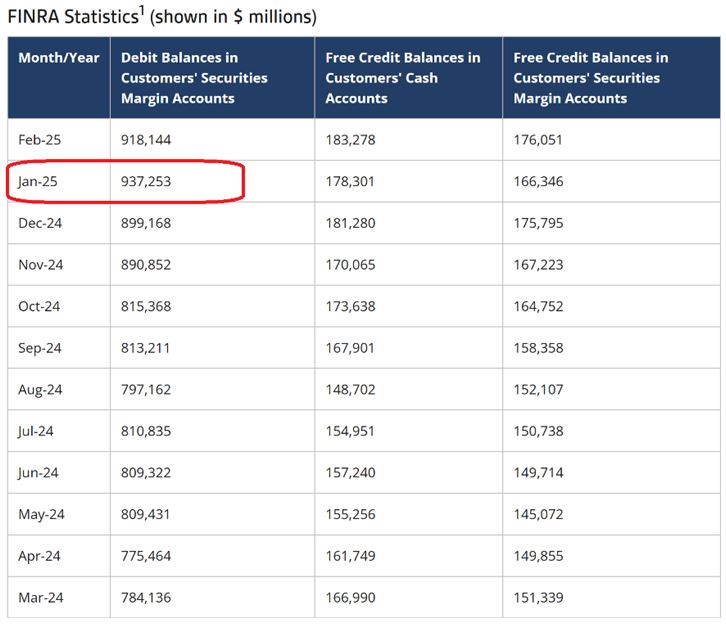
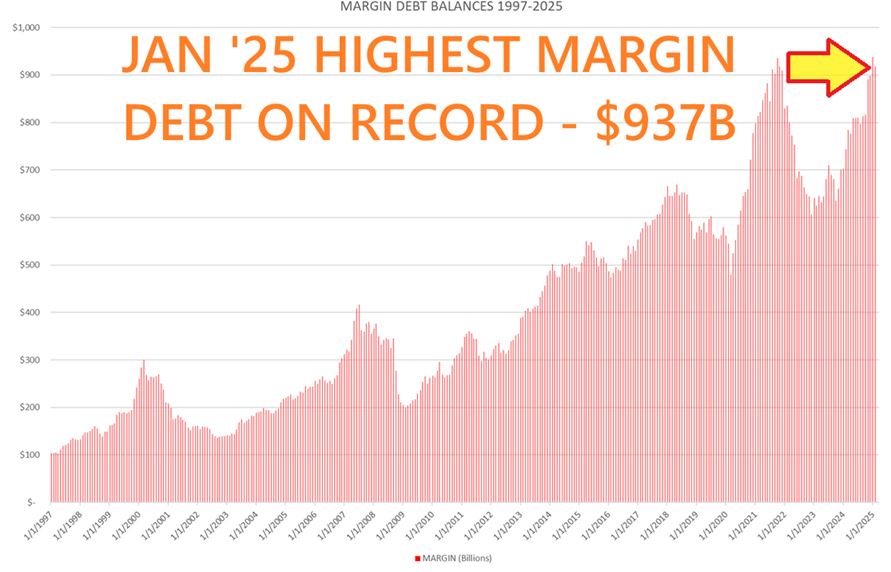
Graphs are for illustrative and discussion purposes only. Please read important disclosures at the end of this commentary.
Big brokers that extended credit to clients suddenly had to adjust their macro-outlook downward to account for unforeseen tariffs, which posed a potential threat to global growth. When this shifted, the firm had to align. Extending credit is great in a steady bull market, but not so great when facing uncertainty.
I believe fund managers received friendly (or firm) margin calls – an order, not a plea, to reduce leverage.
Let’s back up a little. In the second quarter of 2024, there were an estimated 30,000 hedge-funds that managed a collective $5.13-trillion worldwide. I know of funds that run leverage as high is 250% of their asset value. Imagine a medium sized fund of $20-billion needing to take down a few billion dollars of leverage in just a few days. On the surface, an investment account of $20-billion is less than 4/10th of a percent of global hedge fund assets – one hedge fund in a sea of funds – but there are pension funds, asset managers, prop trading firms, and market makers. It is truly mind-boggling when you consider the scope of the market and all its participants – and we aren’t even talking about day-traders or retail investors.
Let’s look at some statistics that may strengthen my hypothesis.
I told you that record margin debt peaked in January at $937-trillion. Looking at February’s number, you will see that it already fell by 2% ($19-billion). The real liquidations took place in March, a number not yet released. I’d wager that when March’s statistics are released, we will see another drop in margin debt.
The torrent of stock selling was relentless for several weeks. Then, it suddenly stopped:
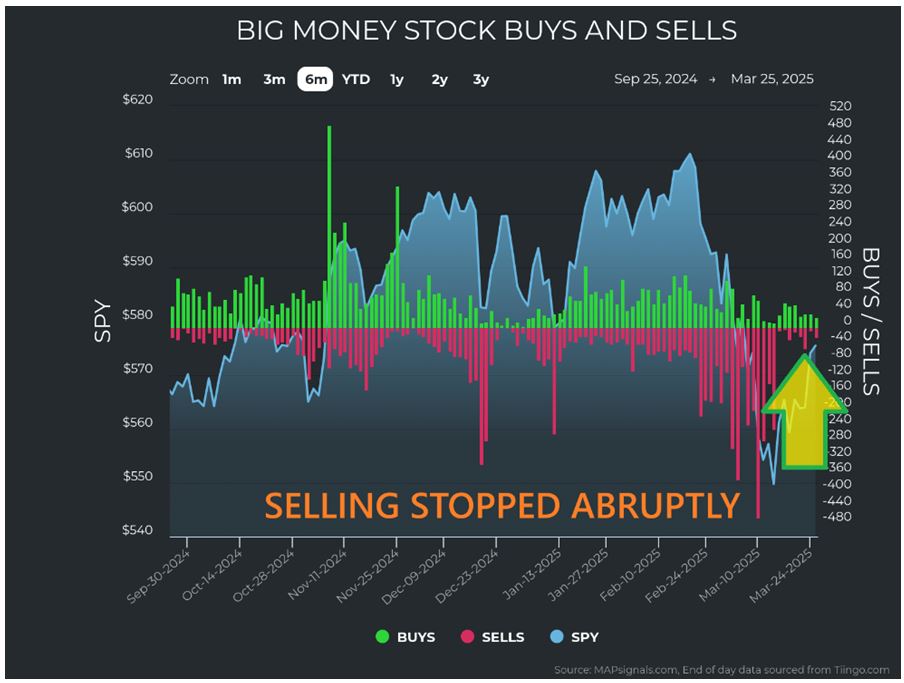
Graphs are for illustrative and discussion purposes only. Please read important disclosures at the end of this commentary.
March 13th was the last day of any notable selling, which might indicate that the accountants told the managers that margin calls needed to be wrapped up by middle of the month in March.
Now, let’s look at how tightly correlated margin debt is to market prices throughout history.
Starting in 1997, as the Internet Bubble swelled, so did leverage. Margin debt ballooned. Then the market ran out of steam and, as leverage had to come down, so did stock prices. Then 9/11 hit the market:

Graphs are for illustrative and discussion purposes only. Please read important disclosures at the end of this commentary.
Next, we see the tight correlation between stock prices and margin debt during the Great Financial Crisis (2007-09). It is the same story: Greed went up, seeking return, so leverage went up. When the market cracked, brokers needed to cover their butts and called in their credit. This forced prices lower:
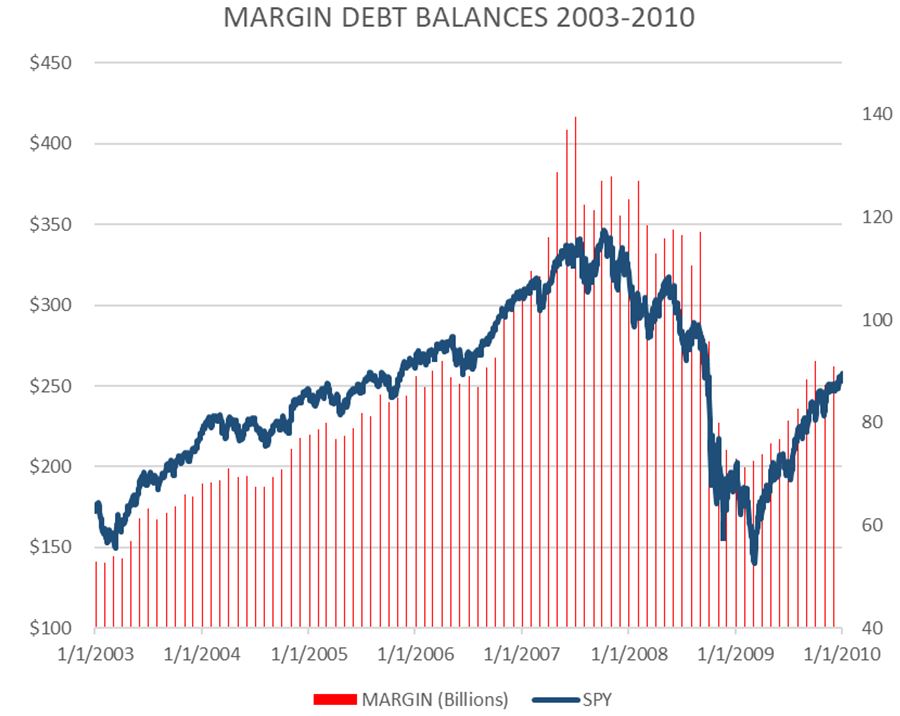
Graphs are for illustrative and discussion purposes only. Please read important disclosures at the end of this commentary.
Here is where we are today:
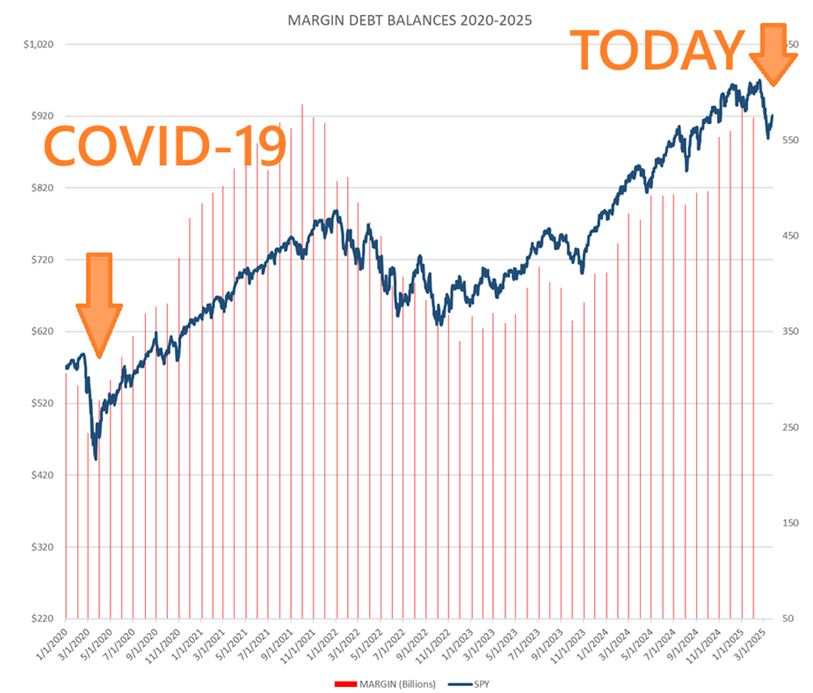
Graphs are for illustrative and discussion purposes only. Please read important disclosures at the end of this commentary.
Margin debt balances will certainly come down. It is also important to note that now does not compare to the Great Financial Crisis or The Internet Bubble. After all, look at the graph above – all the way on the left. That’s COVID-19. Look at the swift recovery and restocking of margin! I think we can all agree that anxiety over tariffs and some federal job losses cannot even come close in scope to what COVID caused.
This is a correction, but not just in the stock market. This is a correction of the use of credit to invest on margin. Leverage got too high. It would have continued, if not for a catalyst. That catalyst was Trump starting his tariff wars, and DOGE starting its war on waste. Those headlines spooked the markets and the analysts. The ones to blame here are really the brokers who extended credit, and the clients demanding it.
This is actually good and healthy for the market. One could argue that the true value of the S&P 500 rises when leverage falls. Look at the above chart inverted:
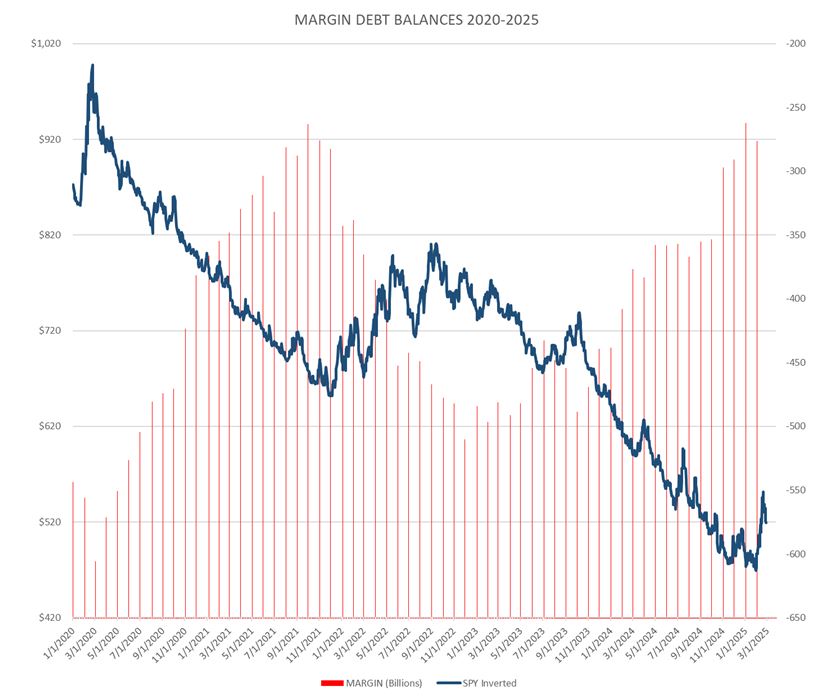
Graphs are for illustrative and discussion purposes only. Please read important disclosures at the end of this commentary.
Now looking back to 2000:

Graphs are for illustrative and discussion purposes only. Please read important disclosures at the end of this commentary.
Last year, the S&P 500 rallied 25%. As a hedge-fund manager looking to beat the market, that’s hard to surpass. That’s why investment managers are incentivized to use leverage as they try to beat a runaway bull market. Brokers are happy to collect interest on their credit extended, just like credit card companies, but when the debts get too big for comfort, after the environment suddenly changes, they circle their wagons fast. Leveraged hedge-funds pay the price as they scramble to “reduce the gross” (leverage).
Investors like you and me look at the sour stock market and blame the headlines or the action of the catalysts. The fact is that it is not that simple… it is even simpler than that!
Greed drives the use of credit. The rug suddenly gets pulled out from underneath traders. Everyone must adjust simultaneously and they all rush for the exits. They don’t have a choice – forced selling caused it.
The good news is that this is cyclical. Like I said, margin debt will certainly be lower when March data is released. Stocks have already started stabilizing. Selling has vanished.
The time to buy great stocks on sale is now. Fear will subside. The economy will recover, and margin will once again drive stocks higher. It’s as predictable as the sun coming up (but always expect rain).
“Into each life some rain must fall” goes back a lot further than Led Zeppelin, in fact to Henry Wadsworth Longfellow’s poem “Rainy Day (1841), which formed the basis for a #1 hit recording by Ella Fitzgerald and the Ink Spots in 1944 – a good year to buy stocks, as it turns out.
All content above represents the opinion of Jason Bodner of Navellier & Associates, Inc.
Also In This Issue
A Look Ahead by Louis Navellier
Trade Talks Escalate as “Liberation Day” Approaches
Income Mail by Bryan Perry
Follow the Money Flows into Stagflation-Proof Assets
Growth Mail by Gary Alexander
Gold is Quietly Dominating the Financial World…Once Again
Global Mail by Ivan Martchev
Beware of the Auto Tariff Quicksand
Sector Spotlight by Jason Bodner
Did Margin Debt Fuel This March Market Madness?
View Full Archive
Read Past Issues Here

Jason Bodner
MARKETMAIL EDITOR FOR SECTOR SPOTLIGHT
Jason Bodner writes Sector Spotlight in the weekly Marketmail publication and has authored several white papers for the company. He is also Co-Founder of Macro Analytics for Professionals which produces proprietary equity accumulation and distribution research for its clients. Previously, Mr. Bodner served as Director of European Equity Derivatives for Cantor Fitzgerald Europe in London, then moved to the role of Head of Equity Derivatives North America for the same company in New York. He also served as S.V.P. Equity Derivatives for Jefferies, LLC. He received a B.S. in business administration in 1996, with honors, from Skidmore College as a member of the Periclean Honors Society. All content of “Sector Spotlight” represents the opinion of Jason Bodner
Important Disclosures:
Jason Bodner is a co-founder and co-owner of Mapsignals. Mr. Bodner is an independent contractor who is occasionally hired by Navellier & Associates to write an article and or provide opinions for possible use in articles that appear in Navellier & Associates weekly Market Mail. Mr. Bodner is not employed or affiliated with Louis Navellier, Navellier & Associates, Inc., or any other Navellier owned entity. The opinions and statements made here are those of Mr. Bodner and not necessarily those of any other persons or entities. This is not an endorsement, or solicitation or testimonial or investment advice regarding the BMI Index or any statements or recommendations or analysis in the article or the BMI Index or Mapsignals or its products or strategies.
Although information in these reports has been obtained from and is based upon sources that Navellier believes to be reliable, Navellier does not guarantee its accuracy and it may be incomplete or condensed. All opinions and estimates constitute Navellier’s judgment as of the date the report was created and are subject to change without notice. These reports are for informational purposes only and are not a solicitation for the purchase or sale of a security. Any decision to purchase securities mentioned in these reports must take into account existing public information on such securities or any registered prospectus.To the extent permitted by law, neither Navellier & Associates, Inc., nor any of its affiliates, agents, or service providers assumes any liability or responsibility nor owes any duty of care for any consequences of any person acting or refraining to act in reliance on the information contained in this communication or for any decision based on it.
Past performance is no indication of future results. Investment in securities involves significant risk and has the potential for partial or complete loss of funds invested. It should not be assumed that any securities recommendations made by Navellier. in the future will be profitable or equal the performance of securities made in this report. Dividend payments are not guaranteed. The amount of a dividend payment, if any, can vary over time and issuers may reduce dividends paid on securities in the event of a recession or adverse event affecting a specific industry or issuer.
None of the stock information, data, and company information presented herein constitutes a recommendation by Navellier or a solicitation to buy or sell any securities. Any specific securities identified and described do not represent all of the securities purchased, sold, or recommended for advisory clients. The holdings identified do not represent all of the securities purchased, sold, or recommended for advisory clients and the reader should not assume that investments in the securities identified and discussed were or will be profitable.
Information presented is general information that does not take into account your individual circumstances, financial situation, or needs, nor does it present a personalized recommendation to you. Individual stocks presented may not be suitable for every investor. Investment in securities involves significant risk and has the potential for partial or complete loss of funds invested. Investment in fixed income securities has the potential for the investment return and principal value of an investment to fluctuate so that an investor’s holdings, when redeemed, may be worth less than their original cost.
One cannot invest directly in an index. Index is unmanaged and index performance does not reflect deduction of fees, expenses, or taxes. Presentation of Index data does not reflect a belief by Navellier that any stock index constitutes an investment alternative to any Navellier equity strategy or is necessarily comparable to such strategies. Among the most important differences between the Indices and Navellier strategies are that the Navellier equity strategies may (1) incur material management fees, (2) concentrate its investments in relatively few stocks, industries, or sectors, (3) have significantly greater trading activity and related costs, and (4) be significantly more or less volatile than the Indices.
ETF Risk: We may invest in exchange traded funds (“ETFs”) and some of our investment strategies are generally fully invested in ETFs. Like traditional mutual funds, ETFs charge asset-based fees, but they generally do not charge initial sales charges or redemption fees and investors typically pay only customary brokerage fees to buy and sell ETF shares. The fees and costs charged by ETFs held in client accounts will not be deducted from the compensation the client pays Navellier. ETF prices can fluctuate up or down, and a client account could lose money investing in an ETF if the prices of the securities owned by the ETF go down. ETFs are subject to additional risks:
- ETF shares may trade above or below their net asset value;
- An active trading market for an ETF’s shares may not develop or be maintained;
- The value of an ETF may be more volatile than the underlying portfolio of securities the ETF is designed to track;
- The cost of owning shares of the ETF may exceed those a client would incur by directly investing in the underlying securities and;
- Trading of an ETF’s shares may be halted if the listing exchange’s officials deem it appropriate, the shares are delisted from the exchange, or the activation of market-wide “circuit breakers” (which are tied to large decreases in stock prices) halts stock trading generally.
Grader Disclosures: Investment in equity strategies involves substantial risk and has the potential for partial or complete loss of funds invested. The sample portfolio and any accompanying charts are for informational purposes only and are not to be construed as a solicitation to buy or sell any financial instrument and should not be relied upon as the sole factor in an investment making decision. As a matter of normal and important disclosures to you, as a potential investor, please consider the following: The performance presented is not based on any actual securities trading, portfolio, or accounts, and the reported performance of the A, B, C, D, and F portfolios (collectively the “model portfolios”) should be considered mere “paper” or pro forma performance results based on Navellier’s research.
Investors evaluating any of Navellier & Associates, Inc.’s, (or its affiliates’) Investment Products must not use any information presented here, including the performance figures of the model portfolios, in their evaluation of any Navellier Investment Products. Navellier Investment Products include the firm’s mutual funds and managed accounts. The model portfolios, charts, and other information presented do not represent actual funded trades and are not actual funded portfolios. There are material differences between Navellier Investment Products’ portfolios and the model portfolios, research, and performance figures presented here. The model portfolios and the research results (1) may contain stocks or ETFs that are illiquid and difficult to trade; (2) may contain stock or ETF holdings materially different from actual funded Navellier Investment Product portfolios; (3) include the reinvestment of all dividends and other earnings, estimated trading costs, commissions, or management fees; and, (4) may not reflect prices obtained in an actual funded Navellier Investment Product portfolio. For these and other reasons, the reported performances of model portfolios do not reflect the performance results of Navellier’s actually funded and traded Investment Products. In most cases, Navellier’s Investment Products have materially lower performance results than the performances of the model portfolios presented.
This report contains statements that are, or may be considered to be, forward-looking statements. All statements that are not historical facts, including statements about our beliefs or expectations, are “forward-looking statements” within the meaning of The U.S. Private Securities Litigation Reform Act of 1995. These statements may be identified by such forward-looking terminology as “expect,” “estimate,” “plan,” “intend,” “believe,” “anticipate,” “may,” “will,” “should,” “could,” “continue,” “project,” or similar statements or variations of such terms. Our forward-looking statements are based on a series of expectations, assumptions, and projections, are not guarantees of future results or performance, and involve substantial risks and uncertainty as described in Form ADV Part 2A of our filing with the Securities and Exchange Commission (SEC), which is available at www.adviserinfo.sec.gov or by requesting a copy by emailing info@navellier.com. All of our forward-looking statements are as of the date of this report only. We can give no assurance that such expectations or forward-looking statements will prove to be correct. Actual results may differ materially. You are urged to carefully consider all such factors.
FEDERAL TAX ADVICE DISCLAIMER: As required by U.S. Treasury Regulations, you are informed that, to the extent this presentation includes any federal tax advice, the presentation is not written by Navellier to be used, and cannot be used, for the purpose of avoiding federal tax penalties. Navellier does not advise on any income tax requirements or issues. Use of any information presented by Navellier is for general information only and does not represent tax advice either express or implied. You are encouraged to seek professional tax advice for income tax questions and assistance.
IMPORTANT NEWSLETTER DISCLOSURE:The hypothetical performance results for investment newsletters that are authored or edited by Louis Navellier, including Louis Navellier’s Growth Investor, Louis Navellier’s Breakthrough Stocks, Louis Navellier’s Accelerated Profits, and Louis Navellier’s Platinum Club, are not based on any actual securities trading, portfolio, or accounts, and the newsletters’ reported hypothetical performances should be considered mere “paper” or proforma hypothetical performance results and are not actual performance of real world trades. Navellier & Associates, Inc. does not have any relation to or affiliation with the owner of these newsletters. There are material differences between Navellier Investment Products’ portfolios and the InvestorPlace Media, LLC newsletter portfolios authored by Louis Navellier. The InvestorPlace Media, LLC newsletters contain hypothetical performance that do not include transaction costs, advisory fees, or other fees a client might incur if actual investments and trades were being made by an investor. As a result, newsletter performance should not be used to evaluate Navellier Investment services which are separate and different from the newsletters. The owner of the newsletters is InvestorPlace Media, LLC and any questions concerning the newsletters, including any newsletter advertising or hypothetical Newsletter performance claims, (which are calculated solely by Investor Place Media and not Navellier) should be referred to InvestorPlace Media, LLC at (800) 718-8289.
Please note that Navellier & Associates and the Navellier Private Client Group are managed completely independent of the newsletters owned and published by InvestorPlace Media, LLC and written and edited by Louis Navellier, and investment performance of the newsletters should in no way be considered indicative of potential future investment performance for any Navellier & Associates separately managed account portfolio. Potential investors should consult with their financial advisor before investing in any Navellier Investment Product.
Navellier claims compliance with Global Investment Performance Standards (GIPS). To receive a complete list and descriptions of Navellier’s composites and/or a presentation that adheres to the GIPS standards, please contact Navellier or click here. It should not be assumed that any securities recommendations made by Navellier & Associates, Inc. in the future will be profitable or equal the performance of securities made in this report.
FactSet Disclosure: Navellier does not independently calculate the statistical information included in the attached report. The calculation and the information are provided by FactSet, a company not related to Navellier. Although information contained in the report has been obtained from FactSet and is based on sources Navellier believes to be reliable, Navellier does not guarantee its accuracy, and it may be incomplete or condensed. The report and the related FactSet sourced information are provided on an “as is” basis. The user assumes the entire risk of any use made of this information. Investors should consider the report as only a single factor in making their investment decision. The report is for informational purposes only and is not intended as an offer or solicitation for the purchase or sale of a security. FactSet sourced information is the exclusive property of FactSet. Without prior written permission of FactSet, this information may not be reproduced, disseminated or used to create any financial products. All indices are unmanaged and performance of the indices include reinvestment of dividends and interest income, unless otherwise noted, are not illustrative of any particular investment and an investment cannot be made in any index. Past performance is no guarantee of future results.
